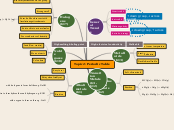Topic 2: Periodic Table
General Trends
Atomic radii
Ionic radii
Electronegativity
Ionization energy
Metalloids (G13)
Solid at room temperature
Semi-conductive
Ductile & malleable
Alkaline earth metals (G2)
Soft, silver metals
Reaction
MCO3(s) → MO(s) + CO2(g)
2Mg(s) + O2(g) → 2MgO(s)
Mg(s) + H2O(g) → MgO(s) + H2(g)
Halogens (G17)
Reacitivity decreases down the group
Strong smell
Form halide when react with less electronegative elements
HX (aq) + H2O (l) → X- (aq) + H3O+ (aq)
Exist as diatomic molecules
Poor conductors of electricity
Noble gases (G18)
Inert (Non- reactive)
Monoatomic
Colourless
Alkali metals (G1)
Easy to cut
Shiny when freshly cut
Reaction
with halogens to form halides e.g. NaOH
with water to form hydroxides and hydrogen e.g. KOH
with oxygen to form oxides e.g. Li2O
